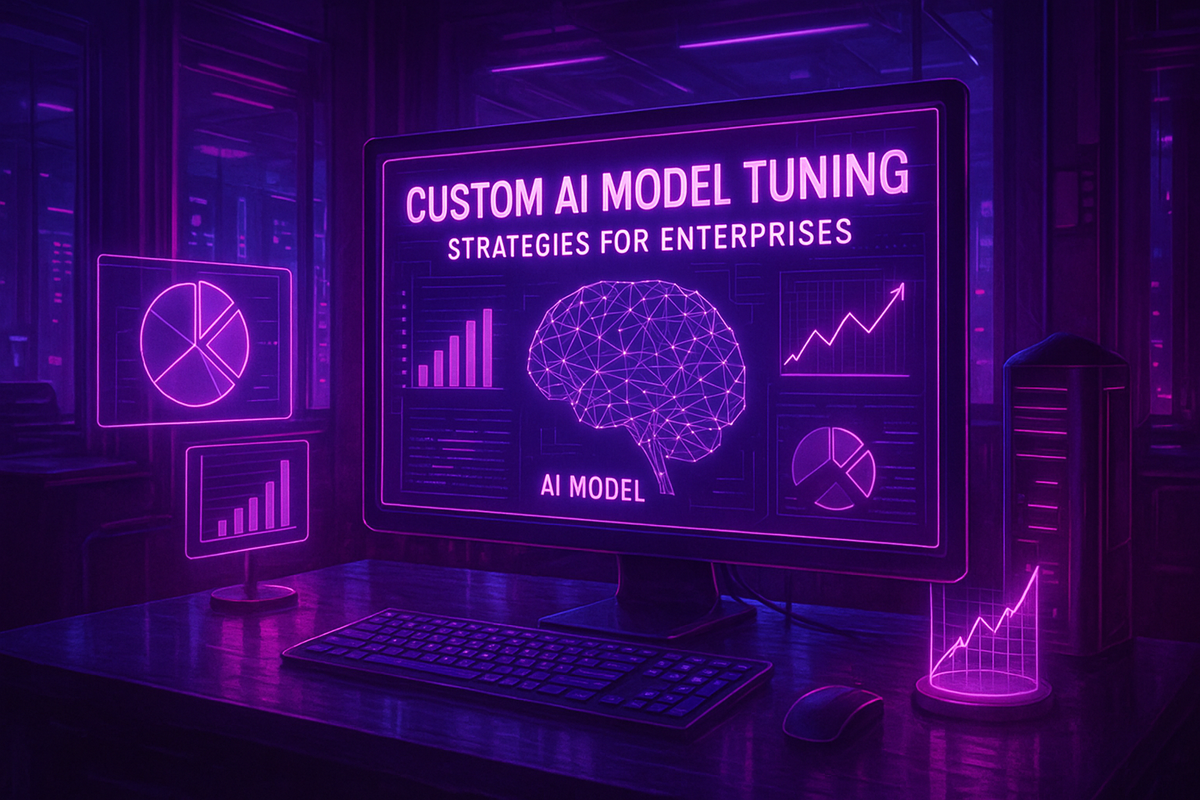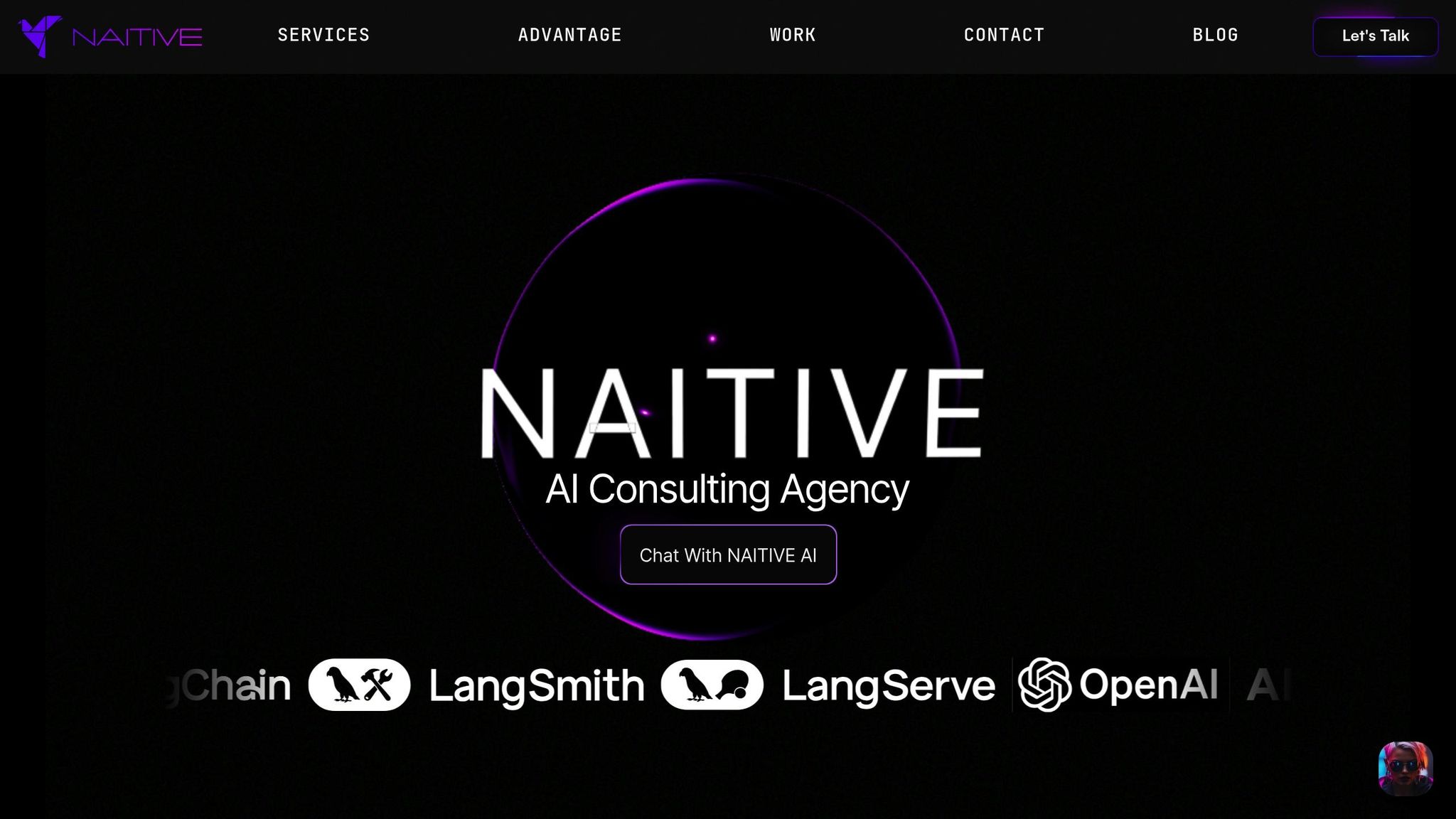Custom AI Model Tuning: Strategies for Enterprises
Custom AI model tuning empowers enterprises to enhance accuracy, navigate regulations, and integrate AI seamlessly into workflows.

Custom AI model tuning is how businesses make AI work specifically for them. Instead of relying on generic AI solutions, companies can refine models using their own data and goals. This process improves accuracy, aligns with regulations, and integrates smoothly into existing workflows.
Here’s what you need to know:
- Why it matters: Generic AI often fails to meet specific business needs. Tuning ensures AI delivers better results tailored to your operations.
- Challenges: Common issues include poor data quality, high infrastructure costs, and navigating complex regulations.
- Solutions: Use specialized data, combine pre-trained models with custom tuning, and set up systems to monitor performance continuously.
When, Why and How to Fine-Tune LLMs for Enterprise Applications
Common Challenges in Enterprise AI Model Tuning
While custom AI model tuning offers immense potential, the journey to implementation is often fraught with obstacles. Enterprise teams frequently encounter a mix of technical, operational, and regulatory challenges that demand careful planning and execution.
Data Quality and Availability Issues
One of the biggest hurdles in AI model tuning is poor data quality. Many organizations discover that their existing datasets are incomplete, inconsistent, or fragmented, making them unsuitable for training advanced AI systems.
For example, customer data is often scattered across various CRM, ERP, and other specialized systems, stored in incompatible formats. This lack of unified datasets directly impairs the fine-tuning process, which is critical for custom AI models to perform effectively.
Another issue is bias in historical data. Legacy datasets may carry outdated practices or demographic imbalances, which can skew model performance. Training AI on such biased data risks perpetuating inequalities, harming brand reputation, and even leading to legal troubles.
Data labeling is another costly and time-consuming challenge, especially in specialized fields. Tasks like annotating medical images or legal documents require subject matter experts, whose expertise comes at a high price. These costs can spiral before a single model is even trained.
On top of that, privacy regulations like GDPR and CCPA complicate data collection and usage. Organizations must navigate these frameworks while building datasets, often relying on anonymization techniques that can degrade data quality and limit model accuracy.
Infrastructure Scaling Problems
AI model tuning isn’t just about data - it also demands robust infrastructure. The computational resources required to train models like large language systems or advanced computer vision tools can quickly overwhelm internal IT capabilities.
Cloud computing costs can balloon during experimentation. Running multiple training iterations on high-performance GPU clusters to test different model architectures or hyperparameter configurations can lead to skyrocketing expenses.
Storage and network limitations also create bottlenecks. Managing terabyte-sized datasets and transferring them over slow networks can delay development cycles and increase costs.
Additionally, many IT teams lack expertise in handling AI-specific hardware and distributed training systems, leading to inefficiencies that further slow progress.
Regulatory Compliance and Ethical AI Requirements
As governments introduce AI-specific regulations, compliance has become increasingly complex. Enterprises must ensure their models meet explainability standards, demonstrate fairness across demographics, and maintain detailed audit trails for decision-making.
Deep learning models, often criticized for their "black box" nature, pose significant challenges in regulated industries like healthcare, finance, and insurance. Without clear explainability, meeting compliance requirements becomes much harder.
Addressing algorithmic bias is another critical task. Continuous evaluation of model performance across different demographic groups, regions, and use cases adds layers of complexity and cost to AI operations.
Evolving data governance frameworks are also crucial. Traditional practices often fall short for AI datasets, requiring updates to policies on data lineage, version control, and access management.
Cross-border data transfer restrictions add yet another layer of difficulty for global enterprises. Differing privacy laws and localization requirements may force organizations to create separate models for different regions or implement advanced anonymization processes.
Finally, the rapid pace of regulatory change means compliance is a moving target. New laws and guidelines frequently emerge, requiring organizations to update governance practices and, in some cases, retrain models to meet new standards. Staying ahead of these changes is essential to remain competitive in enterprise AI.
Understanding these challenges is the first step toward crafting effective strategies for AI model tuning. By addressing these issues head-on, enterprises can position themselves for success in the evolving AI landscape.
Proven Strategies for Custom AI Model Tuning
Tuning custom AI models comes with its share of challenges, from ensuring data quality to maintaining compliance. To address these, enterprises need a strategy that blends technical expertise with business priorities. Here are some proven approaches to get it right.
Use Domain-Specific Data
The backbone of effective AI tuning is high-quality, domain-specific data that mirrors your business environment. Generic datasets often fail to capture the subtle details and complexities of specialized industries, making tailored data critical for meaningful results.
Take the financial services sector as an example. Companies in this space have enhanced their AI models by incorporating real transaction patterns and market behaviors. Instead of relying solely on synthetic or publicly available data, successful organizations focus on collecting and curating datasets that align with their unique operations. This includes factors like customer behavior trends, seasonal fluctuations, and industry-specific language that generic models might miss.
To stay ahead, enterprises should establish continuous data pipelines from their operational systems. This ensures that models remain up-to-date and responsive to changing business conditions. However, building these pipelines requires a delicate balance - preserve valuable context while filtering out irrelevant noise.
Governance is equally important. Implement version control, maintain clear data lineage, and conduct regular quality checks to ensure data reliability. With a robust dataset in place, businesses can then decide whether to adapt existing models or develop custom solutions from scratch.
Apply a Hybrid Buy-vs-Build Approach
Custom AI tuning doesn’t always mean starting from zero. Many organizations find success with a hybrid approach, combining pre-trained models with custom fine-tuning. This method speeds up development while still tailoring the AI to specific business needs.
Pre-trained models provide a solid foundation, allowing teams to focus on fine-tuning for unique use cases. Techniques like transfer learning enable businesses to customize general-purpose models for their specific needs without the hefty computational costs of training from scratch. This approach saves time and often delivers results comparable to fully custom models.
Using established architectures also simplifies updates and integration. When deciding between building or buying, companies should weigh the potential competitive edge. Custom development may make sense for core business functions, while adapting commercial solutions could be sufficient for less critical areas. Partnering with AI platform providers that offer flexible fine-tuning options can further streamline this process, giving enterprises the best of both worlds - control over custom logic and access to ongoing platform improvements.
Once the right model strategy is in place, the next step is ensuring its performance remains consistent over time.
Set Up Continuous Evaluation and Monitoring
AI model tuning doesn’t stop at deployment. To keep models performing well, continuous monitoring and evaluation are essential.
Start by defining KPIs that align with business goals, such as customer satisfaction or operational efficiency, instead of focusing only on technical metrics like accuracy. Use A/B testing frameworks to validate updates before rolling them out fully. Controlled experiments with different model versions help measure real-world impact while minimizing risks.
Automated systems are crucial for tracking performance metrics in real time. Tools like drift detection algorithms can flag when model inputs or outputs deviate from expected patterns, signaling the need for retraining or adjustments.
Feedback loops play a key role in refining models. By capturing user corrections, monitoring prediction accuracy, and analyzing failure patterns, organizations can continuously improve their AI systems. Regular audits of model decisions, along with thorough documentation of updates, ensure compliance with regulations and ethical standards.
Sustaining these efforts requires dedicated teams, clear processes, and a strong technology infrastructure. When done right, continuous evaluation not only keeps models effective but also helps businesses maintain a competitive edge in their AI initiatives.
NAITIVE AI Consulting Agency: Your Partner in AI Model Tuning

When it comes to fine-tuning AI models, having the right expertise can make all the difference. NAITIVE AI Consulting Agency combines years of experience in AI development and enterprise operations to help organizations fully unlock the potential of custom AI model tuning.
Complete AI Consulting Services
NAITIVE takes a tailored approach to AI model tuning, going far beyond just implementing solutions. Their process starts with an in-depth analysis of your organization to pinpoint areas where AI-driven automation can create meaningful improvements. From there, they design AI models that align perfectly with your business needs and goals.
Their support doesn’t stop at implementation. NAITIVE provides end-to-end guidance, from the initial assessment to full deployment and ongoing optimization. By creating domain-specific data pipelines, they ensure your models are powered by high-quality, relevant data - critical for achieving reliable performance. This consultative approach treats AI tuning as a key part of your broader business strategy, aiming for measurable results that directly impact your bottom line.
Expertise in Autonomous AI Agents
NAITIVE specializes in building advanced autonomous AI systems that go well beyond basic chatbots. Their expertise includes developing voice and phone systems capable of operating independently, offering cutting-edge solutions for businesses seeking true automation.
These systems are designed to handle complex, multi-step tasks with minimal human intervention. For example, their voice agents can manage customer interactions 24/7, while other systems tackle intricate operational workflows. NAITIVE’s engineers also use a hybrid approach, balancing off-the-shelf technologies with custom-built solutions tailored to your enterprise’s specific requirements.
Designed for U.S. Enterprises
For businesses operating in the U.S., meeting regulatory and compliance standards is non-negotiable. NAITIVE ensures their AI solutions not only deliver strong performance but also adhere to these critical requirements.
NAITIVE recognizes the importance of delivering clear ROI while maintaining strict data security and ethical standards. Their focus on building long-term partnerships - rather than one-off projects - ensures your AI systems remain optimized and valuable as your business grows and regulations evolve. This approach positions NAITIVE as a trusted partner in driving meaningful change for your enterprise.
Key Takeaways: Getting Results Through Custom AI Tuning
Custom AI model tuning transforms generic models into tools tailored to meet specific business needs. Throughout this article, we’ve seen that achieving success with AI goes beyond simply deploying pre-built models. It requires a thoughtful, strategic approach that aligns with your organization’s unique challenges and goals.
Why Tailored AI Solutions Matter
When organizations integrate domain-specific data and continuously refine their models, they see measurable results. Custom tuning uses specialized data to improve accuracy, lower error rates, and streamline operations. This targeted approach leads to more reliable predictions and stronger decision-making capabilities. Instead of forcing your workflows to fit the constraints of generic AI, tailored solutions adapt to your existing processes, enhancing their functionality.
Additionally, custom-tuned models offer the transparency and control needed to comply with regulatory standards while still delivering high performance. These benefits pave the way for actionable strategies moving forward.
Practical Steps for Enterprises
To fully realize the advantages of tailored AI, enterprises should take a structured approach. Start by evaluating the quality of your data, then adopt a hybrid strategy that combines buying pre-built solutions with developing custom ones. This balance helps optimize costs while ensuring high performance.
From the beginning, set up systems for continuous monitoring and evaluation. These systems help keep your models accurate and relevant as your business evolves and new data becomes available. Regular assessments prevent issues like model drift and ensure your AI remains a competitive asset.
Partnering with NAITIVE AI for Success
For enterprises ready to take the next step, working with NAITIVE AI can make all the difference. NAITIVE AI blends deep technical expertise with a focus on delivering measurable business results, ensuring your investment translates into real-world value.
Their expertise in autonomous AI agents and voice systems makes them well-suited to meet the advanced needs of modern enterprises. Unlike many providers that focus on creating advanced chatbots, NAITIVE AI prioritizes building fully functional AI agents, bridging the gap between AI’s potential and its actual performance.
NAITIVE’s dedication to meeting U.S. enterprise requirements ensures their solutions align with regulatory standards while driving innovation. By treating AI tuning as a strategic business initiative rather than a purely technical project, NAITIVE helps lay the groundwork for sustained success and a competitive edge. Partnering with experts like NAITIVE can be the key to unlocking transformative AI results.
FAQs
What advantages does custom AI model tuning offer enterprises compared to off-the-shelf AI solutions?
Custom AI Model Tuning
Custom AI model tuning gives businesses the chance to build solutions that directly address their specific needs and challenges. Unlike one-size-fits-all AI tools, these tailored models are fine-tuned to align with unique workflows, industry requirements, and customer expectations - leading to better accuracy, efficiency, and relevance.
This approach doesn't just make processes smoother; it can also give companies a strong competitive advantage. By simplifying complex tasks, improving customer interactions, and meeting strict data privacy and compliance standards, custom-tuned AI focuses on what truly matters to your business. It’s about making your AI not just work harder, but work smarter.
What strategies can enterprises use to overcome data quality and availability challenges when fine-tuning custom AI models?
Tackling Data Quality Challenges
To overcome data quality challenges, businesses need to implement strong practices like data validation, cleaning, and labeling. These steps help ensure that datasets are accurate, consistent, and free from biases - key ingredients for developing reliable AI models.
Solving Data Availability Problems
When dealing with data availability issues, scalable storage solutions, such as cloud platforms or enterprise-grade data lakes, can make a big difference. These tools offer real-time access to data, automated governance features, and smooth integration, providing a steady and dependable flow of information throughout the AI model tuning process.
How can businesses stay compliant with changing AI regulations while maintaining strong model performance?
To keep up with changing AI regulations while preserving the performance of their models, businesses should focus on proactive risk assessments and schedule regular audits of their AI systems. It's crucial to align these models with ethical standards, such as conducting bias testing before deployment, to promote fairness and meet compliance requirements.
Creating a well-defined AI governance framework with clear roles and responsibilities can make navigating compliance much easier. Additionally, staying updated on regulatory changes and embedding AI considerations into your enterprise risk management strategy can reduce legal risks while ensuring your AI models continue to perform effectively.




